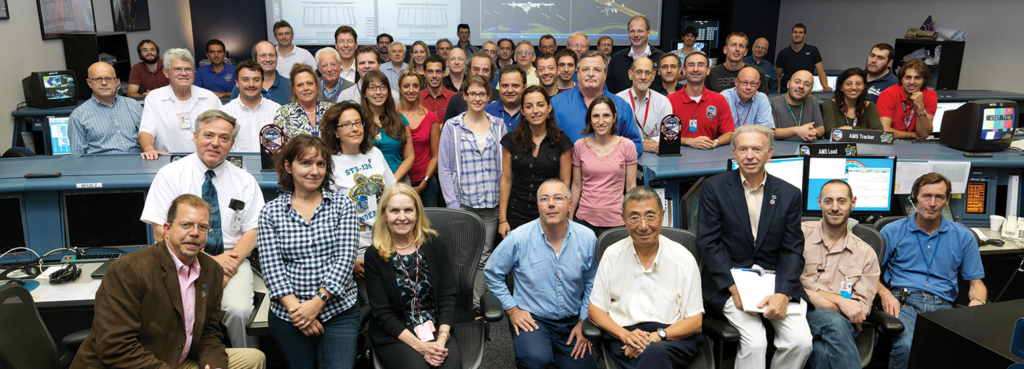Helping NASA Get to Mars and Beyond
It is the dawn of a new era in manned spaceflight. The period of Low-Earth Orbit missions serviced by the space shuttle has made way for a more aggressive push towards exploration, including a return to the Moon’s lunar surface and long-duration manned space missions to Mars and beyond.
However, interplanetary space is permeated by dangerous radiation from galactic cosmic rays, which are charged particles, like protons and ions (atoms that have lost their electrons like helium, carbon and iron), that travel at very high speeds close to the speed of light. Generated from inside the Milky Way and other galaxies, these particles travel long distances accelerated by extremely energetic environments, like supernova explosions, active galactic nuclei (AGN), colliding galaxies and black holes. Galactic cosmic rays remain as one of the most significant barriers involved in long-duration space exploration that extend beyond the natural protection of the Earth’s atmosphere and its geomagnetic field.
As a result, the National Aeronautics and Space Administration (NASA) initiated the Human Research Program to discover the best methods and technologies to support safe space travel. To help them understand and quantify the health impacts of space radiation, one of the most important elements of the program, NASA is relying upon a group led by University of Hawai‘i at Mānoa (UH Mānoa) Associate Professor of Physics Veronica Bindi.
Bindi, who joined the Department of Physics and Astronomy at UH Mānoa in 2012, is an experimental particle physicist and NSF Early CAREER Award recipient who previously worked for 10 years at the European Organization for Nuclear Research (CERN) in Switzerland as part of an international team led by Noble Laureate physicist Samuel Ting of the Massachusetts Institute of Technology. In response to budget cuts that cancelled a superconducting supercollider project that severely reduced the possibilities for experimental high-energy physics on Earth, Ting’s team developed a proposal for a space-borne cosmic ray detector called an Alpha Magnetic Spectrometer (AMS). The prototype, known as AMS-01, was tested on a shuttle mission in 1998.
“Previously, the biological effects of space radiation were studied at particle accelerators on Earth delivering beams of particles to simulate space radiation,” said Bindi. “Because AMS is space-based, it provides us with real and very accurate cosmic ray data, used to improve models essential to assess crew exposure during long missions.”

Samuel C.C. Ting (seated in white shirt) at NASA’s Johnson Space Center. Photo: NASA/AMS-2 Collaboration
The main mission, AMS-02, was delivered to the International Space Station (ISS) in 2011. The state-of-the art magnetic spectrometer onboard will operate until 2028 and is extremely accurate in the measurement of all types of cosmic rays (from 125 MeV to approximately 1 TeV), including solar energetic particles (SEP) emitted from the Sun during intense solar events, such as solar flares and coronal mass ejections.
Shortly after her arrival at UH Mānoa, Bindi quickly established a new group of two postdocs, two PhD students and several undergraduate students from UH and Europe to embark on a vigorous research program to analyze the AMS-02 data. With the full support of Professor Ting, Bindi and her University of Hawai‘i AMS-02 (UH AMS-02) group are the only researchers in the AMS collaboration with a scientific partnership with NASA that is specialized and focused on the study of galactic cosmic rays.
Bindi was initially awarded a one-year start up grant by the NASA Space Radiation Analysis Group based at NASA’s Johnson Space Center in Houston to study low energy galactic proton fluxes measured by AMS-02 and to develop a long-term proposal for future data collected. Impressed by the results, NASA decided to award Bindi and the UH AMS-02 group a $1 million grant to extend the project for five years, to study the time variation of proton, helium and carbon fluxes in the energy range from 1 to 10 GeV, where radiation is expected to be the most harmful.
“In addition to improving the models to study the crew exposure during long missions to Mars, we also want to identify new materials that can be used for future spaceships to better protect astronauts and to predict the best time period for space travel from the solar activity point of view,” added Bindi.
Through these projects, Bindi and the UH AMS-02 group have the opportunity to study the different types of cosmic rays in an energy range and at a precision that has never before been available. Currently, there is very little information about the behavior of cosmic rays inside our solar system, their modulation with the Sun and SEPs at such high energies. AMS-02 will measure cosmic rays and SEPs for several years and during a complete solar cycle. This proposed research program takes advantage of AMS-02’s innovative technology and location above the atmosphere aboard the ISS to provide brand new information to the NASA community about cosmic rays and SEPs, which is currently unobtainable by any other means.
“AMS-02 will contribute to improving the understanding of galactic cosmic rays and solar energy particle physics and improve models, which will lead to better predictions and safer operations in space,” said Bindi. “It is a unique opportunity for the NASA community, the AMS-02 collaboration and UH to contribute to science in an unanticipated way, as is often the case preceding new discoveries.”

